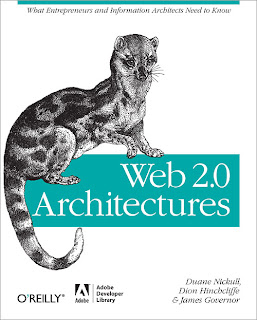Web 2.0
It's disappointing that the O'Reilly book Web 2.0 Architectures: What Entrepreneurs and Information Architects Need to Know (Nickull, Hinchcliffe, Governor) hasn't received more attention and acclaim. It should have. Too many developers today dive headfirst into programming without first appreciating the 10,000 foot view and a sense of how we got here. As the saying goes: if you don't know where you came from, then you don't know where you're going.
For example, how many developers know that Microsoft's introduction of the XMLHTTPRequest (XHR) object to its Internet Explorer browser is what led to the revolution called AJAX (ignited by Google Maps), that underlies Web 2.0? Google has also been behind much of the NoSQL innovations that are now fueling Facebook, Amazon, LinkedIn and other Internet giants. Awareness about how major innovations took place in the past is important because it enables the early identification of opportunities for future innovations.
Dave Winer, who is responsible for many of the technologies that collectively became known as Web 2.0, recently quipped on Twitter: "Web 2.0, whatever that is." He was, of course, conceding that the definition still isn't clear. However, what should be clear to everyone by now is this. Web 2.0 isn't the future, it's the past and the present. It is us looking in the rear view mirror and recognizing that the Internet underwent a sea change with the advent of a number of technologies whose arrival and confluence no one could have predicted.
Call me ignorant, but I learned enough from reading just this book's preface to make it worth my money. As an architect, I am always looking for a succinct overview of the big picture. There's a lot of information out there and few, if any, people can claim to know it all. In fact, Winer's quip was at least partially responsible for me taking the plunge. So, I went looking for a book on Web 2.0 that could paint the landscape rather than get me knee deep into a specific technology (I already have plenty of books that do a good job of that). And although this book has not received the volume of good reviews I would have expected, I could not find a single other book that even comes close to taking on the task, i.e. provide a perspective on what we've learned from the success of Web 2.0 by distilling it into patterns, paradigms, and a forensic (after-the-fact) reference architecture. (Although I will offer a hat tip to Pragmatic Ajax: A Web 2.0 Primer, honestly, with the exception of the MUST-READ chapter 4 on Google Maps, this book jumps right into implementation details and doesn't do half as much justice to the history, patterns, paradigms, and architecture as the book under review.)
A refresher on the history of how the Internet evolved into what we know today as Web 2.0 also drives home the point that there isn't a lot of permanency on the Internet. Many of yesterday's giants (MySpace, Napster, Flickr) have been superseded. We would do well to keep this is mind before buying a ton of shares in Groupon or even Facebook. The book also reminds us that Internet's innovators tend to get gobbled up by established media companies whom the Internet threatens (AOL by Time Warner, Expedia by USA Netwroks, Infoseek by Disney). In this context, also see The Master Switch: The Rise and Fall of Information Empires (Tim Wu).
REST, broadly a minimalist SOA and web services alternative to the additional layers mandated by SOAP. Read this for more on the intricacies behind the debate.
HTTP 1.1 persistent connections and chunked transfer encoding allow content to be streamed rather than buffered.



Comments
Post a Comment